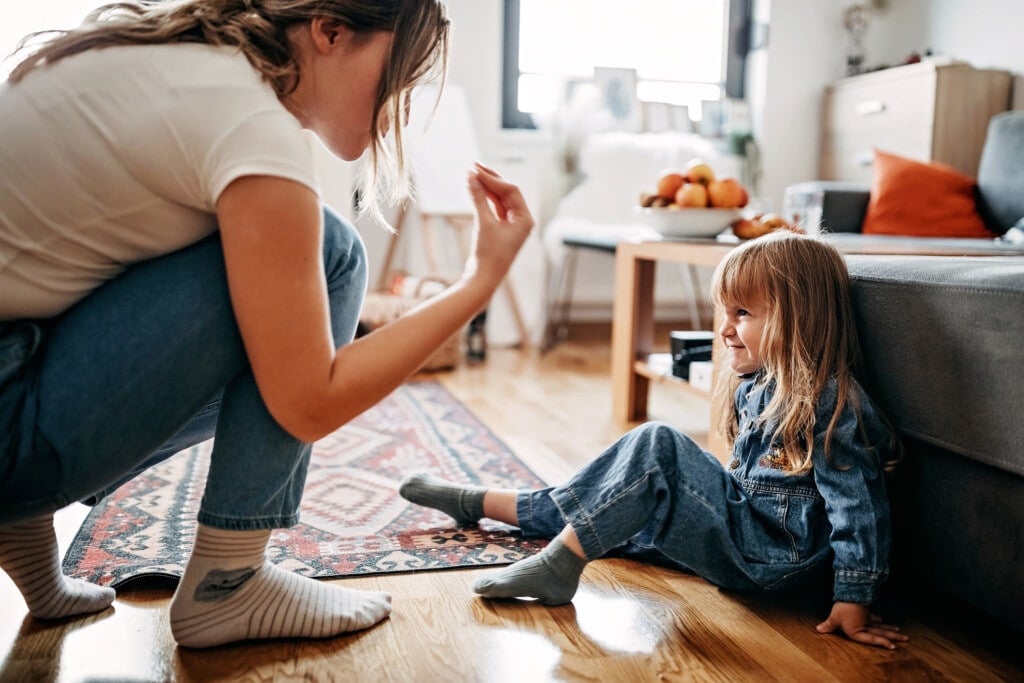Shaming kids is not a great discipline tool. It can be easy to slip into shaming comments out of frustration. You want to try and get some kind of response or reaction from your child. Or perhaps it was the way you were parented. You might say things like:
“You’re such a liar. I can’t believe a word that comes out of your mouth.”
“Why are you crying? It’s not that bad!”
“All you do is whine and complain. You’re being annoying.”
We can easily blurt out these kinds of comments in hopes that our kids will recognize their wrongdoing. Or that it might make them feel bad enough to change their habits. But shaming doesn’t have the effect we think it will and does more harm than good. While we don’t usually shame our kids intentionally, even accidentally, shaming can significantly impact our kids.
Why Shaming Doesn’t Change Kids Behavior
Sure, kids might feel guilty after doing something bad, but that’s not the same as feeling ashamed. The difference is that guilt has to do with feeling that a behavior was “bad” versus thinking “I am bad”.1 There is a significant difference, and shame can have a considerable impact on your child’s wellbeing and your relationship. These areas will have a knock-on effect in terms of them listening to you and complying with rules and boundaries. The behaviors we are trying to avoid are sometimes the behaviors we directly support or magnify with shaming. Here are some of the ways shaming affects our children:
- Shame can lead to lower self-esteem and negative self-talk. When this happens, children can lose faith in themselves (lower self-efficacy or belief that they can achieve).
- Shame can result in your child developing a fake, external “persona” (funny, class clown, overly confident) to hide feelings of inferiority.
- Shame is quite a yucky feeling and hard to sit with. This can lead to frustration or externalized anger/aggression.
- If they feel ashamed and you have done the shaming, they may be less likely to share things with you (to avoid being shamed), resulting in lying or hiding information.
- It can lead to a child being overly competitive or finding it hard to cope with not winning (which can sometimes be expressed as challenging behaviors).
- Shame can result in a lack of motivation to succeed because they no longer believe in themselves. When they don’t feel motivated or don’t feel like they can complete tasks, “be a good person,” or do the right thing, it can negatively impact their desire and ability to cooperate with their parent’s requests/rules (particularly if when there’s the risk of being shamed or not being able to succeed).
- Shame is all-encompassing, making it challenging for children to be considerate and think of others.1, 2
What to Do Instead of Shaming
Discipline is about changing behavior, not necessarily about punishing a child. To change behaviors, you need to consider the following things:
Age of the child.
It is important to consider the developmental age of your child. The expectations for a six-month-old and a six-year-old are significantly different. Each child is unique in terms of development and personality. So, you can’t assume that every four-year-old can be expected to understand or be able to comply with the same requests.
Modeling behavior.
Use “I” statements, like “I feel.” These are you modeling ownership of your own emotions and experiences. This reduces the shaming but still addresses behaviors you would like to see less of. A good example is using the statement, “I feel [insert feeling], when you [insert the challenging behavior, you have noticed] because [tell them why it made you feel that way]. I would prefer [tell them how they can do better next time and to give them a way forward to rectify things].” For instance, “I feel frustrated when you don’t pack up your toys because it leaves a mess that I usually have to pack up. I would prefer it if you could pack away your toys.”
Fill your child’s cup.
If your child feels safe and secure, well fed and watered, and well-rested, they are more likely to be compliant or able to have a conversation with you about their behavior.
Label the behavior, not the child.
Avoid saying things like, “You are a bad girl.” Your child isn’t bad, but the behavior can certainly be challenging. Try to speak to them about specific behaviors that you dislike or are inappropriate. For example, “Lying is unacceptable” instead of “When you lie, you’re being bad.”
Ask for an explanation.
Ask them to tell you what happened instead of assuming and labeling their behavior. You might imply that your child is lazy because they are running late for school. But when you assume you close the opportunity to ask them what happened. When you figure out the barriers to the “right” kind of behavior (behavior you want them to repeat), it gives you all sorts of gold nuggets that will help you support them to develop appropriate behavior to try (or avoid) next time.
For example, “I noticed you were running a bit late this morning. Can you tell me what happened and what we might need to fix for next time to help you get ready on time?” This also helps your child feel independent, strong, and capable if they are involved in coping or managing themselves. And this leads to more beneficial or positive behaviors in the future.
Ask how you can help.
It’s really powerful to ask your child how you can support them. Not only are you protecting your relationship, but you are reaching out and offering love and connection. You’re also helping them with practical tools to address challenges they may be experiencing.3
The most effective tool in your parenting tool chest is your relationship with your child. Having a strong, respectful relationship helps reinforce your child’s positive sense of self. If they feel comfortable with who they are, they aren’t frozen by shame and are more likely to adapt and change their behavior.
No parent or child is perfect. Shaming usually isn’t something that we set out to do. We get stuck, get frustrated, and rely on automatic behaviors rather than choosing to act intentionally. But every time we can be human and authentic and apologize or model our own growth, it goes a long way to show our kids what we expect by doing it ourselves.






























